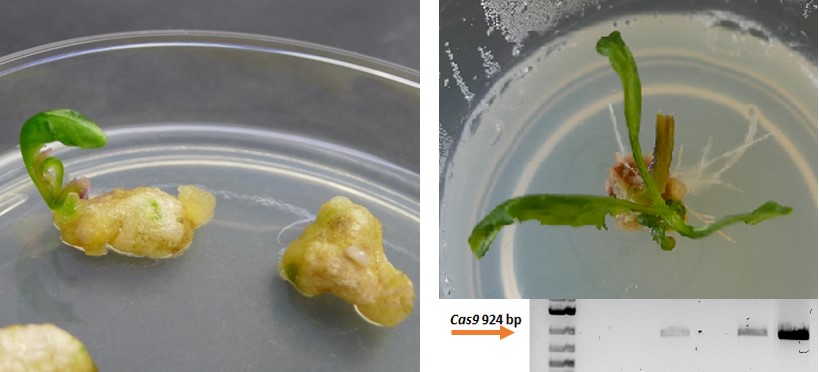Juvenal Assou, Ewa Schneider und Prof. Dr. Traud Winkelmann
Leibniz University Hannover, Institute of Horticultural Production Systems
A prerequisite for genome editing to produce hypoallergenic plants is an efficient transformation protocol for transferring of genetic material. For this, the soil bacterium Agrobacterium tumefaciens (Rhizobium radiobacter) is most commonly used which delivers genes into single plant cells and integrates them into the plant genome. In order to obtain entire new plants carrying the transferred gene from these single transformed cells, a regeneration protocol needs to be established and optimized. These are tasks within subproject P2. Using these regeneration and transformation systems, the constructs for genome editing via CRISPR/Cas (generated by P1-2) will be transformed. While – based on literature knowledge – Indian mustard (Brassica juncea) was considered to be more easy to regenerate and to transform, peanut (Arachis hypogea) was expected to be rather difficult to regenerate and to require much more efforts for establishing and optimizing the protocols.

Right panel: Transformed mustard plant with PCR proof for the gene Cas9.
In mustard, suitable explants (cotyledons of in vitro seedlings), responding lines and an appropriate combination of plant growth regulators were identified that reproducibly result in efficient shoot regeneration. Applying these conditions for Agrobacterium-mediated transformation allowed us to generate the first transgenic lines carrying editing constructs. These plants will now be characterized regarding their Braj1 sequence and regarding their morphology. Furthermore, they will be cultivated in the greenhouse to obtain offsprings.
Also for peanut, young seedlings served as source for explants, i.e. cotyledons, embryo axes and primary leaflets (see photo). While in case of the first two kinds of explants shoot formation from pre-existing meristems can not be excluded that are not easy-to-transform via Agrobacterium, leaflets are promising explants resulting in true adventitious shoot formation. This regeneration protocol is currently further optimized, but at the same time used in first transformation experiments.

Right panel: Shoot regeneration on primary leaflets